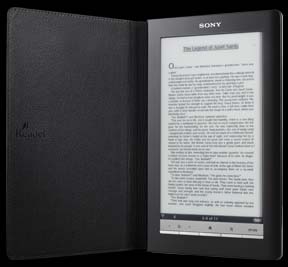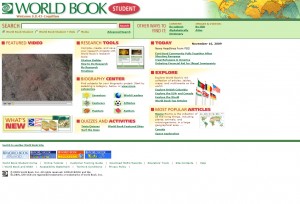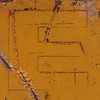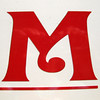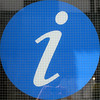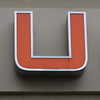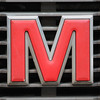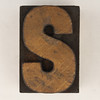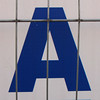Rip*Mix*Feed
For this assignment I put together a Webslides demonstration using Diigo, to look at how Web 2.0 can be used in the classroom. This ties into the final commentary that I did on Web 2.0 and the pedagogical implications.
At first I was hesitant about this assignment, not knowing quite what to do, but as I got into it, I realized that there were a number of advantages, and disadvantages, to using Web applications.
I thought the idea of putting together a slide show of web pages was clever. I collected (bookmarked) a number of web pages that could assist an educator in the class by using Web 2.0 applications. I labeled it ‘Head of the class with Web 2.0’. It is one of the lists in My library.
The site is located at http://www.diigo.com/list/etec540debg/head-of-the-class-with-web-20
Click the green arrow button at the top of the page to view the slides in sequence (as a slide show). If you go into each individual article, you will find helpful literature on Web 2.0 applications, highlighted areas and sticky notes for comments that I made on the literature. They have all been appropriately tagged.
I started out by showing a number of slides that:
- Highlighted the Web 2.0 educational tools that can be found on the web. I followed this up by showing a number of pages on:
- Social bookmarking
- RSS feeds
- Chat
- Wiki
- Podcasting
- Digital Storytelling
- Blogs
- VoiceThread
- A social networking site for teachers
- And finally a study looking at the impact of Web 2.0 on education
I think Webslides is a beneficial tool, however, it is also plagued with a number of issues. I found that the program sometimes appeared unstable – now this just might be my slow computer or security software, however, even at work I encountered these same problems. The ‘highlight’ and ‘sticky note’ functions caused me particular grief – sometimes it would work, while other times it would not, despite repeating the same sequence of events. These functions appear not to work consistently on all web pages. My security software did not like the Diigo toolbar that I downloaded either. Due to the host of technical issues, and the amount of time it took to work out the problems, I am not sure that I would use this process in the future; but it was an interesting exercise.
November 17, 2009 2 Comments
Pictures of the real city of Troy
When I saw Barb Fraser’s commentary on Heroes and accompanying picture of the Trojan horse, I was reminded of my trip to Turkey last spring where the ancient city of Troy was actually located. Here are 2 pictures of the ancient city of Troy near Cenakale, Turkey.

Well, this is not the original, but it does stand at the gates of the Ancient City of Troy.

This is what's left of Troy now. There are 9 layers that they could identify. I think the Homeric Troy was layer 5 or 6. From the top of some of the ruins, you could see a hill where Achilles would have been buried, and another nearby, where Paris would now lie.
November 17, 2009 1 Comment
Electronic books: Not yet the remediation of print
The cost of digital alternatives has been a factor in their adoption. E-books read using a home computer are cost effective since few people in developed countries do not already own a PC capable of running the required software. However, the initial cost of purchasing a dedicated e-book reader, particularly for fiction, is still prohibitive. There are also lingering issues of portability, readability and battery life, though these are certain to be addressed over time. For non-fiction materials, particularly encyclopedias and reference works, however, portability works to the advantage of e-books and uptake has been faster and more enthusiastic. High school students are content to use electronic versions of reference works that are, in print form, typically larger, heavier, and available for shorter loan periods than other types of materials. And, in addition to 24/7 availability online, electronic reference books offer the advantages inherent in most digitized material: “Specifically, electronic documents are usually searchable, modifiable, and ‘enhanceable.’ ” (Anderson-Inman & Horney, 1997, p. 487). At the post-secondary level, where students purchase their books, electronic texts are popular with a majority of students for many of the same reasons (Hawkins, 2002, p. 45). “As with any remediation, however, the eBook must promise something more than the form it remediates: it must offer what can be construed as a more immediate, complete, or authentic experience for the reader” (Bolter, 2001, p. 80). Again, to date, this is most true for reference works and most notable for encyclopedias.
Fanfiction.Net (www.fanfiction.net Nov. 11, 2009) employs attributes of Web 2.0 popular with teenage readers. Fanfiction, as the name suggests, is a site that allows users to write chapters and scenes based on their favourite works (novels, plays, movies and television shows), and publish them to thousands of readers. Readers can browse these user creations by category and read them online as long as they have a computer with an Internet connection or access to one in a school or public library. The fan compositions reflect the interests and preoccupations of the time, and reach a wide audience through Internet publication facilitated by categorization, searchability and interactivity (ratings and reviews). Forums and communities allow readers and writers to discuss their works, the shows and books on which they are based and a wide range of related topics. English, literature and creative writing teachers would do well to co-opt the enthusiasm for this type of interaction with popular culture to encourage students to write for a much wider audience than that available in the classroom or the school. Interestingly, while Fanfiction incorporates many Web 2.0 affordances, it is also still linked strongly to the metaphor of the codex. Hawkins (2002) sums up the current situation well: “E-books will survive, but not in the consumer market—at least not until reading devices become much cheaper and much better in quality …. The e-book revolution has therefore become more of an evolution.” (p.48).
References
Anderson-Inman, L. & Horney, M. (1997). Electronic books for secondary students. Journal of Adolescent & Adult Literacy, 40 (6), 486-491.
Bolter, J.D. (2001). Writing Space: Computers, Hypertext, and the Remediation of Print. Mahwah, NJ: Lawrence Erlbaum.
Hawkins, D. T. (2002). Electronic Books: Reports of their death have been exaggerated. Online, 26(4), 42.
November 17, 2009 2 Comments
Travel Timeline Remix
I used this Xtimeline tool because I wanted to try a timeline tool out from Alan Levine’s list and I wanted to create a timeline progression of my information and images provided under the Creative Commons copyright from Flickr (the remix part) of a vacation to England and Wales over a three week timespan to show where I was on each day – it was a very busy trip! I think this tool works reasonably well, however, it did not want to have more than one item for a single day regardless if there were different times of the day for each item (how frustrating). It worked fairly simply and easily, but had some foibles such as the multiple items on the same day issue which was irritating. This also made me much more selective with the images that I used, as my plan was to have multiple images for each day perhaps this is a good thing though too as it does make the timeline too specific. Some good components about Xtimeline was that it had a built-in keyword tool and a location for the image / text source citation which was a nice touch. There are also some interesting tools to import / export the timeline as a CSV (comma delimited file) or XML (extensible markup language file), so you could built it outside of Xtimeline and then bring it in or out. Hope you enjoy the presentation!
http://www.xtimeline.com/timeline/My-Favourite-Vacation–Traveling-Around-England—Wales
November 16, 2009 6 Comments
Photo Remix
I had a ton of fun with this activity. I used dumpr.net to remix this photo of my son. I have to admit, it was an easy task, but I spent TONS of time deciding on the best image to use and what filter to apply. I have done a few others that I will print out for my kids so they can colour themselves. Enjoy!

Get your own photo sketch
November 16, 2009 1 Comment
Commentary #2 Literacies and Information Architecture
Mandala Making Activity——-
—–As a preface activity to the commentary I would like to invite classmates to review an online example, or generate their own Mandala of Muliliteracy as a way to conceptualize the organization of each individual’s concepts. Feel free to peruse the http://win-dev.communication.utexas.edu/mandala/ communication course website and check out a sampling of other ones on the site.
The Dobson and Willinsky article provides a broad scan of the many meanings of digital literacy, for which they consider technological literacy to be a synonym (p 15, 2009). The paper asks us to focus also on the impact that digital literacy will have socio-culturally. This article served as a springboard to explore the theme here that information architecture skills are integral to successful learning. This would correlate with a structural meaning-making context, after Cope & Kalantzis (p 11, 2009)
The authors make the distinction between traditional literacy and new literacy—they encourage us to view literacy as a social practice, not an individual skill (page 15, 2009). Digital literacy is a presented as a subset of information literacy. The 1989 definition of information literacy (page 18, 2009) cited from the American Library Association is as follows “To be information literate, a person must be able to recognize when information is needed, and have the ability to locate, evaluate, and use effectively the needed information”. Learning to learn is a saying often applied to describe general information literacy.
Matthews-DeNatale (2009) believes “There are at least three pieces to the puzzle. One piece is information technology fluency, one is information literacy, and another piece is media literacy. And they’re all overlapping, like a Venn diagram.” Information management is a part of multiliteracy skills, and will be the focus of this report.
Dobson and WIllinsky also cite earlier work (p 16, 2009) by Dobson (2005) in which he proposes “Digital literacy, therefore, assumes visual literacy and entails both the ability to comprehend what is represented and the ability to comprehend the internal logics and encoding schemes of that representation”. This definition implies that one needs to understand the structure behind the information directly accessed in the media, and so associated with every representation of “data” is metadata.
With projects such as Project Gutenberg, Million Book Project, Google and others the authors refer to (p 17, 2009) today’s student has access to millions of references, and information in multiple media around each subject they may wish to explore.
Dobson and Willinsky propose that accessing multiple nodes between the links in a highly associative environment can be disorienting to a learner (page 7, 2009). This best applies to learners transitioning from traditional learning environments, not to Digital Natives. The authors do clarify that a person with good resident domain knowledge will do better in a high network situation, as they can more easily integrate situational information from this environment with their schemata (page 8, 2009).
Managing information in a digital environment is changing learning both in and out of the classroom. Bookmarking has surfaced as a key way to manage large sets of links on the desktop. Del.icio.us is a perfect example of how an individual can scaffold his or her learning by gradually building up more and deeper resources as understanding of a subject increases. This software allows sharing of bookmarks to further enhance functionality. This sort of tool is good example of the way that digital literacy skills can transform research, which used to be a singular activity, done in libraries’ book stack and index searches, into a highly social activity with potential for many people at great distance and of varying ages and cultural backgrounds to contribute to the process. According to Dede (2008) “RSS feeds, sophisticated search engines, and similar harvesting tools help individuals find the needles they care about in a huge haystack of resources”.
The authors refer to the fact that the unit of importance is now the post, not the page (page 20, 2009). This means that more threads and small packets of information must be managed now that microcontent is king. Behind microcontent is the web of user tags that add another dimension to the material. These linking tags allow pooling of learner knowledge of the data, by the process of cumulative novel associations.
The old way of filing and accessing material was hierarchical and taxonomic. Current information management in multiliterate learners often revolves around folksonomy (Neil, after Vander Wal, 2007). Folskonomy is defined on the EDUCAUSE website as the application of user-defined tags (so-called folk classifications) by an open group of people to categorize units of information ([n.d]). By adding tags to visual or other data in their work, learners can make powerful associative links, and even generate tag clouds, to conceivably make new meaning over and above the data itself. Folksonomy structures such as at Digg, CiteULike and others, provide a new way to manage content. New tools allow one to make a visual representation of the metadata. Generating information architecture over and above the base information is a widespread user-generated experience for the first time in history.
The ability to customize the desktop and files within a personal digital appliance is another way that information literacy skills can enhance learning. Personal Learning Environments (PLEs) provide powerful information structuring, which provides opportunity for deeply customized user-directed learning. PLEs can provide a way for the user to select only those modes of learning and manage information as is best suited to their learning style(s).
Informal learning environments such as games such as SimCity, and social networks (Flickr, Facebook, YouTube) also provide a new way to make meaning by providing situated learning and constructivist experiences. By accessing a path to a level of information which is appropriately in the zone of the student’s development, the comfort of the learner will be enhanced. On YouthVoices for example, young learners share their media together and have online discussions around those materials in a comfortable self-selected sharing environment.
Dobson and Willinsky acknowledge the challenges facing today’s learners when they say “And there are very real issues around too much information, in the form of inundated mailboxes clogged with spam and a World Wide Web that can seem at times overwhelmingly wide, if less than very deep”. (p 22, 2009). If educators are cognizant of the power of information architecture as a component of multiliteracy, then optimizing teaching around this strategy will help the learner focus effectively on both their individual and collaborative learning.
Unorthodox and novel strategies will continue to evolve as software evolves. Google Wave is a high priority research tool for that company because it integrates many multiliteracy tools in one place for streamlined sharing and organizing of information. This is an excellent example of how tools are evolving quickly to come to the aid of web 2.0 users in integration of information architecture. Draude (2009) feels educators should answer the question “Maybe we should look at how to help a student figure out what is the priority information—not what information does the student have to know, but what information can the student go find that will supplement what he or she knows? Dobson and Willinsky (2009) cite a similar theme from a 1989 work by Lemeke regarding students learning independently, using metamedia and information literacy; they quote Lemeke saying”…places the emphasis on “access to information, rather than the imposition of learning”. Draude and Lemeke’s statements certainly represent a new appreciation of just how important information architecture is.
References
Cope, B. & Kalantzis, M. (2009) ‘Multiliteracies’: New literacies, new learning. e-published March 17, 2009; Accessed online November 5, 2009 at: http://newlearningonline.com/~newlearn/wp-content/uploads/2009/03/m-litspaper13apr08.pdf
Dede, C. (2008). A seismic shift in epistemology. EDUCAUSE REVIEW, Vol. 43, No. 3. Pp 80-81. Accesssed online November 15, 2009 at: http://www.educause.edu/EDUCAUSE+Review/EDUCAUSEReviewMagazineVolume43/ASeismicShiftinEpistemology/162892
Dobson, T., Willinsky, J. (2009). Digital literacy. Cambridge Handbook on Literacy. Accessed online at: http://pkp.sfu.ca/files/Digital%20Literacy.pdf
EDUCAUSE. Folksonomies [n.d]. Accessed online November 15th at: http://www.educause.edu/Resources/Browse/Folksonomies/30459
Neal, D. (2007). Folksonomies and Image Tagging: Seeing the Future? ASIS&T Bulletin. Accessed November 15, 2009 online at: www.asis.org/Bulletin/Oct-07/neal.html
Schaeffer, S., Fry, M., Droude, B., Matthews-DeNatale, G. (2009) Information literacy and IT fluency. EDUCAUSE REVIEW Vol. 44, No. 3 pp 8-9. EDUCAUSE Learning Initiative (ELI) Annual Conference podcast at: <http://www.educause.edu/NewTechPodcast>.Under Creative Commons License3.0
Websites Referred to:
Youth Voices http://youthvoices.net/legg/
SimCity http://simcitysocieties.ea.com/index.php
digg http://.digg.com
Flickr http://www.flickr.com
citeulike http://www.CiteULike.org
facebook http://www.facebook.com
Google Wave http://wave.google.com/help/wave/about.html
November 16, 2009 1 Comment
Rip.Mix.Feed using PhotoPeach
I chose to document my hiking trip to Torres del Paine, Chile for this assignment in PhotoPeach: http://photopeach.com/album/nu40ux. My husband Mark and I travelled there in December 2004 and completed a 65 Km hike that was a really amazing journey! I chose PhotoPeach because I had used it before in my last MET course and liked how it allowed me to add captions, select music to go along with the photos, and I liked how the photos sort of dance on the screen. I also liked the fact that I could tailor the speed of the slide show to ensure that it wasn’t too slow and would be over before the music finished.
I chose the song “Gold in them Hills” to accompany the photos because the lyrics speak of the importance of appreciating all things in our lives even when life is getting us down and being hopeful too. There were days during the hike when it was a tough slog, but I kept on going and felt very inspired by the beauty of the scenery. Also, on the last day of the hike, we got very close to the “Torres”, the steep granitic towers which made the hike even more worthwhile. They really were the “gold in them hills”.
November 16, 2009 3 Comments
Heavy Heroes: More than just memorable
The Cultural and Psychological Roles of Heroic ‘Heavy’ figures and of the Bizarre in Ancient Mythology: More than just memorable
Walter Ong asserts, in his discussion [pp 69 -71] that the heroic tradition [meaning the great works of Homer (the Iliad, the Odyssey et al)] and the great pantheon of gods of ancient mythology, specifically that of the Greeks, was an outcome of the inherent characteristics of “primary” oral culture and of early literate culture. According to this interpretation of the attributes of oral culture, oral residues include a necessary structural mnemonic component in terms of what is included in works of poetry and literature. Ong states that these works include what he has termed “…type figures, wise Nestor, furious Achilles, clever Odysseys….” that is, that these figures constitute typologies. (Ong, 2000 pp 69). It will be shown in this discussion that, these ancient works do indeed present specific “types” but that their appearance function primarily as expressions of cultural values and psychological types, which has very little to do with mnemonics.
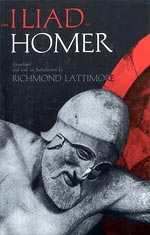 A culture of War [1]
A culture of War [1]
It will be shown that these stories arose out of an evolutionary meshing of critical points of juncture, framing a “space” where personal & psychological history and cultural values and mythology complexly intersect. It will be demonstrated that it is not the needs of an orality based culture but the language of the Unconscious and the needs of a military based culture, that provided the impetus for the creation of the bizarre psychological types and “heavy” dramas that are portrayed in these works.

More than just a clever ruse: An ancient psychodrama [2]
The connection between psychoanalytic theory [especially Freudian and Jungian] and literature [especially ancient classical mythology] is intimate and complex, indeed among the honours Freud received in his lifetime, was the prestigious Goethe Prize for Literature (Nelson, 1963). In Freudian psychology, many of the fundamental concepts, [for example parapraxis, dreams, symptoms] have direct analogies within literary theory. Specific psychoanalytic constructs constitute a sort of involuntary language, with its own laws and logic, which serve to define and describe the operation and nature of the Unconscious, within the Freudian concept of the psyche [Orlando 1978].
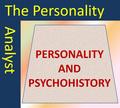 Personality and History fuse together in Psychoanalysis [3]
Personality and History fuse together in Psychoanalysis [3]
Mythology and mythological analogies are fundamental and integral to the central theoretical construct of Freudian psychological theory; the Oedipus Complex, which is based upon Sophocles Oedipus Tyrannus {Morford & Lenardon, 1991]. It would be dismissive of the entire field of psycho-analysis [and of much “talk therapy”] to conclude that the roots of the frequently bizarre and strange characters from these ancient stories is driven by the need to make them memorable in the sense of easier to recall, rather than by a fusion of complex psychological and cultural values, needs and characteristics.
It has been suggested that the Iliad reveals not just the attributes and characteristics of the Heroes and the gods of the mythological world but also serves to illuminate many aspects of features of Homeric and Classical Greek culture, providing insight into the ways that the Greeks viewed or perceived themselves and their society (Armstrong, 1993).

A cast of characters expressing psychological types and cultural values [4]
In terms of values or ethics, it is clear that within the mythical world of the Iliad, human beings are continually and dramatically playing out their predestined roles within specific well-constructed constraints, which are imposed upon their agency or range of actions, by the gods. Human beings are controlled by and subservient to, various levels or hierarchies of power [both divine and human] and domination.
Not surprisingly, in a world defined by graduations or degrees of tyranny [with the great warring kingdoms as political models], and within a story chiefly concerned with the consequences of war, the virtues [or passions] manifest in the Heroes of the Iliad [Achilles, Hector, Priam] are those that fit a military paradigm of ‘greatness’. Thus, martial values are asserted, among them, two extremely praised attributes are those embodied in the concepts of “Honour” and “Glory” defined within a specific set of military values and ethics [sic] of Greek military, partriarchical, tyranny based culture.
In summary, the story of the Iliad is clearly concerned with asserting the validity of the ‘honour culture’, which the Greeks held in such high esteem though the actions and examples of both gods and men. The power relationships between man and the divine are interactionist, that is, the same passions and character flaws plague both the Heroes and the deities. The gods participate in aspects of humanity and the Heroes participate in aspects of the divine in a complex and dialectical fashion. Nowhere in all of this, whether in terms of cultural values or in terms of psychological needs, does the role of mnemonics figure as having primacy.
 Achilles: A Postmodernist Hero? [5]
Achilles: A Postmodernist Hero? [5]
Ong asserts the notion that mnemonics, and the needs of orality [as though it was in itself an entity] or of an oral based culture, are more important than the cultural values or psychological forces at play here. Ong states “…. all of this not to deny that other forces beside mere mnemonic serviceability produce figures and groupings….” and that “…psychoanalytic theory can explain a great many of these forces…”. Clearly, psychoanalytic theory and cultural forces explain the vast majority of factors at work, and mnemonic structure [like the well documented use of repetition of phrases and of whole scenarios] was a secondary, even minor attribute to these great works. The critical or primary function of these works was to support or validate cultural beliefs [representing specific values] and to express the language of the unconscious [through the representation of universal attributes] as it functions within the human psyche.
The importance of the universality of some of these values, the cultural specificity of others, and the deep psychological underpinnings of these characters and their behaviors, can be dismissed if taken at surface value. However, such surface interpretations can be misleading. These stories portray humans as being at the mercy of, or aided by, divine powers, with questions about mortality and morality often left unanswered. Indeed the great questions posed in stories like the Iliad are not resolved, and seemed shrouded forever in ambiguity.
For me these stories resonate well in our highly technical and highly literate society, even these thousands of years after they were passed down to us. These works are not merely bizarre stories from the past, made easier to remember because of their strange set of characters. Ambiguity itself is asserted within them [a very post modern concept] and functions as a sort of mythic signifier or semiotic sign, of those realities that constitute the significant and universal components of the human experience and of what it means to be human.
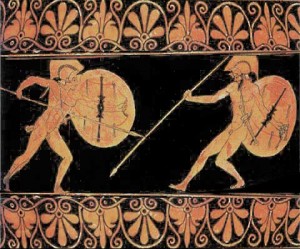
An eternal conflict plays out in the human psyche as well as the battlefield [6]
November 16, 2009 2 Comments
I had to try this one too!
November 16, 2009 1 Comment
Commentary # 2 : Curiosity Killed the Cat !

Bolter in his book explains about devices of navigation and orientation throughout the history of writing, from the evolution of hypermedia (from ancient oral poetry) to how it is informed by critical theory and shapes writing. He considers writing spaces as spaces that include both written products and types of written production, including illuminated texts, printed books, web pages, typewriters, and word processors. He analyzes changing nature of print, and of writing spaces as they become more visual even in electronic writing, digital writing, hypertext and hypermedia. He considers that, text becomes a textual aid that brings order and unity to the images. According to Bolter hypermedia can be regarded as a kind of picture writing, which refashions the qualities of both traditional picture writing and phonetic writing (p. 58).
However, through those chapters that I have read till now, I feel a soft deterministic way of approaching to technology by Bolter. Although throughout the book and even at the preface, he tries to explain about it, but from time to time, a continuing of Ong’s technological determinism (that was discussed previously in “From Orality to Literacy”) can also be traced in Writing Space.
In general, Bolter believes that the technical and cultural aspects of writing are so closely tied together that it is impossible to separate them and they both combined the technology. He sees technology and culture as two things that influence and create each other. Bolter does not reject the benefits and advantages that technology provides, but reminds that users share equal responsibility for the achievements. In this way, he tries to distance from technological determinism.
My curiosity to find possible influences of Ong and others on Bolter’s soft determinism, led me to search for the refernces of Writing Space at the end of the book. I was surprized when I found chapter 11, “The Web Site” just before the references. It was only one page. In that chapter, Bolter explains that a Web site, is often to provide ancillary material that the book omitted due to limitations of space or the limitations of the printed medium itself. Perhaps the main reason for having a Web site is simply to extend the reach of the text, to establish a colony in the new territory of cyberspace (p. 214). The URL address of the associated Web site of Bolter’s book is http://www.lcc.gatech.edu/~bolter/writingspace/
I was so curious to have a look at it and find what Bolter considers as an extension, and a remediation, of the printed text, containing additional information, corrections, and improvements. As Bolter says “It (Web site) also remediates the printed text by making a modest claim to interactivity, in the sense that visitors to the site can register comments and criticisms, which will be recorded and made available to subsequent visitors”. However the link didn’t work. I tried it again and again but I faced with the same message, “The requested URL was not found on this server”. I searched for the server and found it to be located in Georgia Institute of Technology. Bolter’s academic homepage is also available in that server and it works!
It was surprising for me that a writer be aware of reading his book by students in different universities and is reluctant to update the web address of his book, especially when considering web technologies as a remediation of printed text. I continued my search to find the original URL address that aimed to associate Bolter’s book. However, during my search, I was surprised by an article in Computers and Composition Journal in 2002, a year after the print of the new version of the book. In that article Barton, from the University of South Florida, stated that “the web site advertised in his (Bolter’s) last chapter was not functional at the time of this writing”. According to his harsh criticism “Perhaps this could be a reason for so many scholars preferring print. Another reason for this preference might be to achieve the notoriety that scholars like Bolter acquire when they publish books! If Bolter had produced a web page instead of a book, would I be reviewing him now in a scholarly (print) journal? I wish that Bolter had addressed these perplexing ironies” (Barton, 2002). However, I agree with Barton that such ironies can not reduce the effectiveness of Bolter’s Writing Space.
Now, in spite of Bolter’s emphasize on the dynamic and heterogeneous visual experience that the Web offers, I feel that the link of the book’s Web site has never worked for all of these years. I could imagine that by adding a website for his book, Bolter would critically analyze and show the changing structure of writing spaces by looking at the evolution of writing and spaces of writing. Bolter’s use of Web, as technology that promises the future, was a big disappointment for me.
In the recent years due to dynamic characteristic of Web, maybe Bolter has felt that it is not still necessary to defend the idea of electronic writing in practice, in the form of a Web site, as significant, since it is no longer the case. Today’s culture is far more wired and open to Web and Web-based communication that it probably be more important to try to understand the importance of Web as new writing technology in teaching and learning.
Let me finish up here with a beautiful saying from Rumi, written 800 years ago.
“Either exist as you are, or be as you look”
References
Barton, M. D. (2002). Book review, Computers and Composition, (2002). 499–502.
Bolter, D. J. (2001).Writing Space Computers, Hypertext, and the Remediation of Print. New Jersey: Lawrence Erlbalm Associates.
November 16, 2009 3 Comments
Rip/Mix/Feed
First of all, this activity is really FUN! Just following the links suggested on the Rip/Feed/Mix wiki page had me totally involved and entertained for over two hours. I’m a big fan of http://cogdogroo.wikispaces.com and I was initially going to do this activity with Roxio Photo Story. However, I used that tool in my own wiki posting for 540, and I thought I’d try a new one.
I wandered over to http://search.creativecommons.org/ and somehow found a link to http://bighugelabs.com/ and once there, Mosaic Maker seemed perfect. I had to create a free account, which is tied in to my Yahoo account, which is then tied in to Flickr. Interesting path of convergence on Web 2.0! There was an option to sign up using Facebook, but I thought Yahoo was more secure. Using Mosaic Maker, I linked to Flickr and searched Creative Commons images that were free to adapt, remix and reuse. I wanted to make a mosaic that reflected the computeras a communication tool. I saved the images in my Flickr favourites, and then Mosaic Maker searched my Flickr favourites to create the mosaic. Pretty simple, yet highly networked!
BigHugeLabs encouraged me to include the html code from the images, in order to give credit to the people who uploaded to Flickr. Here are the references automatically created by Mosaic Maker:
1. Informatics 2005/2006 Creative Commons photo-patchwork, 2. Computer History Museum, 3. Silicon Gallies – Next Generation Glass Tile Pendant – Black Laptop Computer Key – CTRL ALT DELETE Necklace, 4. Computer Testing, 5. die computer die 2.22.07, 6. Computers, B&W, 7. Build Your Own Z80 Computer, 8. Predicting the Computer of 2004 in 1954, 9. Apple: Keep Your Lawyers Off My Computer, 10. Computer History Museum, 11. Computer Graveyard, 12. Controlling a Computer with Eyes
November 16, 2009 No Comments
Commentary #2: The Fragmentation of Print
Bolter argues that hypertext is remediating print forms, offering a dichotomous view separating print from hypertext, separated on the basis of links and imagery and arguing the benefits of imagery will supersede print. Will hypertext overwrite print due to inherent qualities such as flexibility and relation to natural ways of processing ideas which cross cultural and linguistic lines? The reader is forced to consider which form will become dominant, print or imagery:
“Although the writer and reader may use words to describe and interpret the pictoral message, two readers of different languages could share the same system of picture writing.” (Bolter, 2001, 59)
While he questions the effectiveness of voiceless picture writing on its own, he purports that through hypermedia we realize “a kind of picture writing, which refashions the qualities of both traditional picture writing and phonetic writing.” (58)
Bolter argues that hypermedia and eBooks offer increased flexibility to printed books in that they do not align themselves end to end on a shelf, rather “merging into the network of the World Wide Web, the electronic book invite exploration as part of a network of texts.” (81) Bolter asserts that books must be complete units in themselves, and despite their physical proximity to other books, they become completely separate once placed on a library shelf. While the idea of linking books, texts and images is interesting I question the value of this approach for all types of literature.
The issue Bolter has failed to address to this point is the reasonable applicability of image and link based hypermedia to all forms of text. Hypertext emulates magazines and newspapers in its marriage of images to text, offering unparalleled means to further exploration of ideas and concepts through linking nodes of information that allow the reader to follow paths of links through endless pages on the World Wide Web. In encyclopedic form, hypertext offers a flexibility for the reader to explore subjects according to personal interest and in relatively effortless ways as were required in former volume-based, shelved books while images allow readers to appreciate context with less apparent description. This form of hypertext, however, is not necessarily the ultimate solution to all forms of text. Qualitatively, the text offered in such forms as magazines, newspapers, and encyclopedias differs greatly from that of prose text found in fiction.
Focusing on hypertext, this form does offer increased reader control through their organization of ideas “that can arrange themselves into a kaleidoscope of hierarchical and associative patterns-each pattern meeting the needs of one class of readers on one occasion,” (Bolter, 2001, 91) this encyclopedic example ignores the needs inherent to the narrative form. Current novels are written in a linear and arguably male organization of linear storylines, building tension, climax and denouement. The novel form favours author centred and directed, linear exploration of print while hypertext offers reader centred, open, non-linear exploration of links which span infinite pages and represent a multitude of variations of ways to explore the same available material.
Does hypertext, which indeed offers possibilities for certain forms of text that seem to represent an extension of inherent qualities of the texts themselves, offer the best solution for all texts? The narrative form favours a closed author centred approach to reading and exploring text. Would hypertext, despite all its possibilities, fit in with the demands of the narrative form? Readers explore such texts as novels by following the direction of the author. Rather than viewing this as a negative aspect of linear based fiction, it seems more reasonable to appreciate the unique forms and qualities of various texts which arguably determine their effectiveness in various forms of textual representation. In the 1980’s hypertext-like narratives emerged (Moulthrop, 1995), such as the Choose Your Own Adventure novels for youth which made their debut at this time. This type of book offered a hypertext-like situation where the reader navigated through the narrative by deciding on the course of action for plot and then turning to the appropriate page in the book to pursue the decided upon storyline. Despite this exciting innovation in reading, the Choose Your Own Adventure hypertext-like approach to reader centred fiction did not replace traditional novel forms.
If we use this example to compare such forms as magazines and newspapers, encyclopedias and novels in the advent of hypertext, we could argue that before the advent of hypertext possibilities, the simulated hypertext forms of the encyclopedia and hypertext and image based forms of the magazine and newspaper existed independent of computer based hypertext and imagery. While computer based hypertext allows the inherent qualities of these forms to become stronger, the form reduces the importance of authorship in the important form of fiction and the novel. Who is to be in control of the text? Do the readers control all forms of text, including story lines? And how would this play out? As readers, would we accept stories that we decided on our own, through creating outcomes and producing a fragmenting of literary outcomes in a myriad of possible storyline directions? Stuart Moulthrop suggests that such reader directed programs violate “our sense of commitment, at least to the extent that this is denied in terms of…’selfish interaction,’ or an assumption that the story really does exist to please us.” (73) Hypertext writing seems to change the act of writing in that it forces writers to envision and created a multitude of possibilities in accordance with the demands of the readers. The novel form then becomes “a textual space within which his fiction operates… [whereby] the reader joins in actively constructing the text by selecting a particular order of episodes at the time of reading.” (42) Despite the fact that the author still controls the text that is read, the text is only secondary to the choices made by the reader.
In terms of imagery, while images can carry meaning beyond descriptive possibilities, can this strength inherent to images overwrite the text in narrative? Bolter suggests that “[b]y combining alphabetic writing with images and diagrams… designers are defining the computer as a writing space that vacillates between intuitive and abstract modes of representation….where the verbal text must…compete for the reader’s attention with a variety of pictoral elements.” (Bolter, 2001, 61) While he admits this utilization of images falls in line with the particular material, it is important to question the blanket idea that pictoral images could replace all writing forms which utilize pure text as a medium. The genre of the narrative novel does not necessitate simply due to its textual makeup, inclusion in the realm of hypertext and image based alterations that will occur as a result of computer based forms. Bolter’s use of weighted words, such as “exploited,” (73) when discussing the exclusive use of text in creating and presenting prose offers a glimpse into the negative view he carries with regards to the exclusive text mediums such as that of narrative.
Whether or not a change from “books to electronic webs carries the force of historical necessity” as suggested by Bolter and Lanham, or will simply result in a fragmentation that will create new outlets for writing is yet to be seen. In the introduction of literacy in the era of orality, oral forms of communication were not entirely overwritten or erased. Both oral and literary forms continued to flourish and evolve according to benefits, possibilities and limitations of each form. In the same way, I argue that hypermedia and traditional text forms will develop and coexist as benefits, possibilities, and limitations are determined.
While it is impossible to accurately predict the future of either hypertext of print, it seems unnecessary to assume a total and complete overwriting of one system over another. Traditional literary narrative forms may indeed branch off to include hypertext version, but traditional narrative forms such as the novel may be best left to the print form. Hypermedia may allow for a permanent fragmentation of narration to include hypertext literature, whereby hypertext books will become readily available in addition to traditional print forms. Imagery may allow for increased image-based literature (such as is evident in comics), but primary utilization of images reflects a varying set of possibilities, benefits, and limitations that are not equivocal to the narrative novel form. While film seems to be the closest we have come to realizing a shift towards pure image in narration, it is important to remember the text base of most films. Such blockbusters as the Harry Potter, Lord of the Rings, or Twilight series, My Sister’s Keeper, and the Boy in the Striped Pajamas are just a few. Just as communication branched into the areas of literacy and orality in the face of the new literacy, perhaps fiction will branch into multiple areas including, but not limited to, traditional print forms and hypertext versions in accordance with social, literary, and fiction writing demands.
References
Bolter, J. (2001) Writing space: Computers, hypertext, and the remediation of print [2nd edition]. Mahwah, NJ: Lawrence Eribaum.
Bolter, J & Joyce, M (1987) Hypertext and creative writing. University of North Carolina. Accessed at: http://portal.acm.org/citation.cfm?id=317431
Moulthrop, S. (1995) Traveling in the breakdown lane: A principle of resistance for hypertext. Accessed at: http://iat.ubalt.edu/moulthrop/essays/breakdown.html
November 16, 2009 1 Comment
Commentary # 2: Multiple Intelligences, Hypertext and Hypermedia: Are They Connected?
Commentary # 2: Multiple Intelligences, Hypertext and Hypermedia: Are they Connected?
by Delphine Williams Young
ETEC 540 University of British Columbia November 15, 2009
The continuation of the remediation of print in human history as explored by David Bolter (2001) implies that humans are always engaged in the process of configuring ways to improve the transmission of information and ideas. Bolter suggests a tension between visual and print modes that is also continuing in education, despite the unregulated and unstructured journey from medieval iconography to print, then to photographic and electronic visual presentation. “It is interesting to speculate how photography, film, television and multimedia might have been developed and used, if Western cultures could somehow have jumped over the technology of printing and gone directly from iconography to photographic and electronic visual presentation” (Bolter, p.55). According to Bolter, visual technologies had to struggle to highlight themselves within a culture of prose and the earlier verbal rhetoric. (p. 55). Could it be that this recursive pattern somehow connected to the way in which Howard Gardner (1993) represents human intelligence? Could it be the source of this disorganized development of writing technologies?
Gardner’s theory emerged from cognitive research and suggests that there are seven multiple intelligences which can be used to describe the way humans perceive and interact with the world as intelligent beings, which are the: linguistic, logical mathematical, musical, bodily-kinesthetic, spatial-visual, interpersonal and intrapersonal ( (Mckenzie, 2005). Despite documenting these seven, Gardner suggests that there are others which he attempts to describe in his later work but these seven have been useful to educators. They help to determine individual differences and have allowed many teachers to target their learners effectively. Could it be that the shifting which has been taking place throughout the ages, which Bolter articulates as “a process of cultural competition between or among technologies” (p.23), be as a result of the various different individuals possessing varied multiple intelligences? Bolter suggests that the shift which occurs as remediation usually takes place when new technology replaces an older one by “borrowing and reorganizing the characteristics of writing in the older medium and reforming its cultural space” (p. 23). The writing done on papyrus remediated oral communication by allowing for the eyes and ears to be involved and so giving the words “a different claim to reality” ( p.23). The persons involved in effecting this remediation all possess a very constant variable, their humanity. With an application of Gardner’s theory there is a very likely possibility, in addition to the human desire to improve on existing technologies, that many of the inventors and innovators throughout history possessed varied learning styles which propelled them to add and subtract in order to arrive at technologies which seem to address all seven multiple intelligences. Hypertext is one such technology.
In this century, “hypertext”, according to Bolter, is not without hypermedia which offers so much more to the reader than the printed word. Bolter sees it as offering a “second challenge to the printed book” (p.47). The current old fashioned print which may seem like simple and natural communication, at this cultural moment, especially to those who are perhaps not digitally literate, in comparison to the electronic hypertext might not seem so in the years to come. It might actually more natural for some information to be represented as hypertext (Bolter, p. 46). An examination of hypertext reveals that all the multiple intelligences are represented in the way the technologies are combined. I say combined whilst Bolter proclaims ‘remediation.’ For linguistic learners which learn through words and language there is text to be read and to be responded to by the user. There are logic and numbers to be manipulated by the logical-mathematical learner. Sound, music and rhythm are available and easily accessed for those who are musically oriented. Images and spaces are varied for spatial learners. According to Sherry Turkle (2004) “[f]or some people cyberspace is a place to act out unresolved conflicts, to pay and replay characterological difficulties on a new and exotic stage” (p. 23). Virtual communities offer opportunities for adolescents and young adults to interact anonymously with different identities in an attempt to concretize their own sense of self. Both the interpersonal and the intrapersonal intelligences are catered for as individuals interact with each other using the above media. Finally, the bodily-kinesthetic is addressed in two ways. The tools and equipment are handled in the process of using them and there are visual media which portray motion that the user can get involved in. An example of hypertext combined with hypermedia which is can be recognized as the World Wide Web.
Whilst Bolter cites several educational theorists who have examined the effectiveness of hypertext and hypermedia as new dialogic forms, he also recognizes that the academic community is showing reluctance to participate in some of the refashioning that writing technologies have undergone. The World Wide Web that I find very useful is sometimes rejected as not having material of high calibre. Bolter also points out that popular culture which includes “the business and entertainment world and most users have shown little interest in a serious critique of digital media, but they are all eager to use digital technology to extend and remake forms of representation and communication” (p.118). If the hypertext and hypermedia have remediated print to the extent that they are capable of addressing all the various multiple intelligences, then educators need to embrace them as they did the multiple intelligences, then the quality of instruction will improve and learning will be maximized. The experience that educators had while learning the original classic works will change, and continue to undergo change, so rather than resist the change educators will have to join in and become digitally literate. A book though not able to address all human needs will still be easier to carry and handle than an electronic one will. This does not change the idea that educators need to listen to the inner voice of the students like these.
References
Bolter, D. J. (2001). Writing Space Computers, Hypertext, and the Remediation of Print. New Jersey: Lawrence Erlbalm Associates.
Gardner, H. (1993). Frames of the Mind: The Theory of Multiple of Intelligences. New York : Basic Books.
Mckenzie, W. (2005). Multiple Intelligences and Instructional Technology. Washington: iste Publications.
Turkle, S. (2004). Whither Psychoanalysis in Computer Culture. Psychoanalytic Psychology , 16-30.
Worchester. T. (2009). Multiple Intelligences and Technology. Retrieved from http://www.tammyworchester.com/Home/html
November 15, 2009 2 Comments
Commentary # 2
The Shrinking World. Literacy and Culture in the Digital Age
A Commentary on Bias and Technology
By David Berljawsky
Submitted to Prof. Miller
Nov 15, 2009
Modern technology has made the world a more streamlined and connected place. However there are many benefits and shortcomings that have arisen. One only needs to be aware of the way that hypertext has been developed to understand the inherent problem of digital technologies. It was created with a particular culture in mind, and represents the creator’s technological ideals and values. Despite this it is used by many different cultures around the world “…Freire’s ideas undermine the local commons by transforming indigenous ways of knowing, making them more susceptible to economic and technological globalization and thereby contributing to the loss of traditional ecological knowledge systems… (Bowers, from Lange, p.355).” Despite the aforementioned misgivings, there are many positives found about the current state of hypertext and the modern age. This paper will examine how the current hypertext revolution affected different cultures and the pros and cons of digital literacy in cultural terms.
If one looks at hypertext as a commodity, then it has been nothing but a smashing success. It has for all intents and purposes transformed our world. There is now an increase in long distance communication, global boundaries have been shrunk and news and media are more available than ever before. As with nearly every commodity there are people who benefit from it more than others do. IT technologies not only have a bias, but often have technological limitations that handicap other cultures. “The cost of the new technologies, the geographic isolation of many communities, low levels of computer literacy and lack of awareness of how to technologies might serve indigenous goals and interest have led to this low adoption of the technology (Dyson, Hendriks and Grant, p.10).”
There is no question that modern internet technologies benefit the dominant western culture. Other cultures need to tread carefully when using this technology. Its usage can initially be seen as exciting and as having the ability to advance one culture and knowledge. “Writing is often regarded at first as an instrument of secret and magic power (Ong, p.92).” Remember, writing and literacy is a technology.
How does this affect other non-dominant cultures? In terms of culture and identity much can be lost. If internet technologies are used to share values, transmit beliefs and other culturally specific ideals this can negatively affect the authenticity of the culture and their literary technologies. They are using a medium that was not designed for them, and is not representative of their values, education system and beliefs. “Similarity, it is the nature of the computer that determines which patters of thinking, communication, or experiencing will be reinforced as well as which patterns will be marginalized or represented as nonexistent (Bowers, et al, p.186).”
If we continue down this path much will be lost. Other forms of literacy, that are not of the western dominant style will be changed to a hybrid of their original style and of modern western based technology. Perhaps they will be lost completely. Computers and internet technologies are not around to promote multicultural values. Ultimately they are a commodity and need to be viewed as such. “The computer industry has multibillion dollar reasons for maintaining the myth that computers are a culturally neutral technology. (Bowers et al, p.184).”
In terms of literacy there are many benefits to living in this day and age. One major benefit of modern technology is the ability to educate using the internet and computer. There are certainly positives to using this technology to promote literacy. “Certainly, digital literacy carries with it the potential for a far wider, more global access to knowledge… (Dobson and Willinsky, p.1).”
Students are able to communicate with other cultures and learn from each other like never before. This increased multicultural knowledge can be enhanced through the internet. There are also countless software applications that allow students to increase their literacy and typing ability. It is imperative that educators realize that they should not simply rely on these technologies to teach because of the dependence that it can create. They also need to educate about the technologies inherent bias and shortcomings to allow students to be able to make their own decisions. “Increasingly, students come to online learning with preconceptions gathered from both formal and informal experience in virtual environments. They exercise their mastery of communication norms and tools, some of which are not appropriate to an educational online context (Anderson, p.48).”
There is always the danger with certain cultures that they will use modern technologies to promote their causes and improve literacy. “Individuals and whole culture do mold techniques and devices to their own purposes, but the material properties of such techniques and devices also impose limitations on their possible uses (Bolter, p.20).” Often, when a culture or group becomes too attached to a technology, they lose something else. We may develop an increase in digital literacy, but we will likely lose a form of non-digital literacy in return. This is a form of progress, and can be seen as either positive or as a negative as long as one is aware of it happening. Postman discussed this in great detail in Technopoly, “If it makes sense to us, that is because our minds have been conditioned by the technology of numbers so that we see the world differently than they did. Our understanding of what is real is different (Postman, p.13).”
In conclusion I believe that it is important for educators to understand that literacy is evolving. We no longer can take for granted that all students are going to have learned literacy in the older, old fashioned way. It is important to understand that the internet is also not the most culturally advanced tool out there. However with the proper education and understanding of its biases it can advance the quality of life, and education for many cultures. Educators need to be aware of this because without the proper knowledge of how to manage and harness this technology it can hurt the longevity and authenticity of a culture “…but as its use expands and intensifies, so does the ‘overseeing gaze’ of encapsulation policies and transnational corporations (Prins, p.7).”
References
Ong, Walter, J. (1982). Orality and Literacy: The Technologizing of the Word. London and New York: Methuen.
Postman, N. (1992). Technopoly: The surrender of culture to technology. New York: Vintage Books.
Bolter, Jay David. (2001). Writing space: Computers, hypertext, and the remediation of print [2nd edition]. Mahwah, NJ: Lawrence Erlbaum.
Dobson, T, & Willinsky, J. (2009). Digital Literacy. (OlsonD., TorranceN., Ed.). Cambridge Handbook on Literacy. http://pkp.sfu.ca/files/Digital%20Literacy.pdf [Book Chapter]
Lange, Elizabeth A. (2007). Transformative Learning: The Trojan Horse of Globalization? Concordia University College of Alberta. Alberta, Canada.
Prins, H. E. L. (2002). Visual Media and the Primitivist Perplex: Colonial Fantasies, Indigenous Imagination, and Advocacy in North America. In Faye D. Ginsburg, Lila Abu-Lughod, and Brian Larkin (Eds.), Berkeley Media Worlds: Anthropology on a New Terrain, (pp.58- 74). University of California Press.
Anderson, T. (2008). Toward a theory of online learning. In T. Anderson & F. Elloumi (Eds.) Theory and Practice of Online Learning, Chapter 2 (pp. 45-74). Available online at: http://www.aupress.ca/index.php/books/120146
Bowers, et al. (2000) Native People and the Challenge of Computers: Reservation Schools, Individualism, and Consumerism in American Indian Quarterly, Vol. 24, No. 2 (Spring, 2000), pp. 182-199.
Dyson, L. Hendriks, M & Grant, S. (2007) Information Technology and Indigenous People. United States of America, Information Science Publishing.
November 15, 2009 1 Comment
From tangible to electronic
Commentary #3 – In response to Bolter, Chapter 5 The Electronic Book from Writing Space
Much thought continues to go into the shift from the book to the electronic book. That is, an electronic entity that replaces the need for a tangible book. Bolter (2001), in Chapter 5 – The Electronic Book of his book Writing Space, explores the differences, similarities, practicalities and otherwise significant characteristics of both the book and the emerging electronic versions of it. This chapter begs the reader to contemplate the affordances of the electronic book and think critically about how the nature of the book will continue to evolve. Beyond unpacking the implications of the electronic novel, Bolter discusses the electronic book in general and his discussion warrants a further look at the electronic version of textbooks and books used for research purposes. Interestingly, I find it uncomfortable to use the word “book” for the purpose of this commentary when referring to an electronic book. The word “book” itself denotes the sense of containment afforded by a cover, a back and a spine. The open-endedness of technology means that book wouldn’t be the appropriate term, but rather electronic information or electronic resource, would be more appropriate when referring to electronic versions of the tangible book.
There is no question that the book in its tangible form represents a sense of permanency in comparison to its digital counterpart. We are re-envisioning the way we look at print resources and at its technological counterpart and we have now come to have expectations of print as a result off what is available via technology. Bolter notes, “as we refashion the book through digital technology, we are diminishing the sense of closure that belonged to the codex and to print” (2001, p. 79). The very nature of technology requires that information is constantly evolving and there is a sense when visiting sites online that upon a return visit, changes will have been made. Working in special education, we refer to Individual Education Plan’s (IEP’s) as “living documents”, that is, documents that don’t remain fixed but rather change and evolve as necessary. This parallel works well with Bolter’s discussion but warrants the question of how evolving and living information can be appropriately organized. This is where hypertext becomes the defining technological feature that allows the information itself to dictate the nature of organization. Bolter says “its organization, the principles by which it controls other texts, and the choice of organizing principles depends on both the contemporary construction of knowledge and the contemporary technology of writing” (2001, p.84). The contemporary technology that we are currently using to further the precision by which we organize is hypertext, and that hypertext is creating parallels and links between information in a way that the tangible book simply cannot. A common challenge presented by the tangible book is the ability to collect, in one location, enough sources to properly conduct research.
Whereas pre-technological forms of organization only allowed for a piece of information to be housed in one category, electronic affordances remove the issue of quantity. As a university student, I was often frustrated by the fact that the perfect book to help support my thesis would be on loan, and I would be forced to wait or settle for different, and sometimes seemingly lesser, information. By storing resources digitally and organizing it appropriately, I would argue that the nature of research would actually improve because of the greater access afforded by electronic information. Bolter’s Chapter 5 leads me to believe that the ideal situation would be to have access to giant online encyclopedia that incorporates links to all related books on a subject (scanned in and searchable through the Google Books Project naturally) and all related sites through the use of hyperlinks. While Wikipedia exists as a popular encyclopedia, the openness it allows in editing articles does not make the Wiki conducive to facilitating electronic books.
Earlier in Writing Space, Bolter argues “in graphic form and function, the newspaper is coming to resemble a computer screen, as the combination of text, images, and icons turns the newspaper into a static snapshot of a World Wide Web page” (2001, p.51). While books may not be able to resemble a computer screen as easily as a newspaper, there is certainly a need for innovation in the presentation of books given the technological culture we now live in. While Kindle and other systems have continued the evolution of how a story is told, there needs to be a system by which informational texts can be made electronic and further improve the nature of how we come to know about a subject. Already, electronic textbooks contain links and virtual activities that have enhanced the learning experience. Bolter lays the framework for analyzing the nature of improvements that moving to the electronic book will afford and it is clear that electronic books will lead to greater access and therefore greater understanding of information now contained outside of the container of a tangible book.
References:
Bolter, Jay David. (2001). Writing space: Computers, hypertext, and the remediation of print [2nd edition]. Mahwah, NJ: Lawrence Erlbaum.
November 15, 2009 1 Comment
Remix photo
I chose to remix a photo. The original photo was found on flickr and is a photo that the user ‘Whiskeygonebad’ had taken in 1976 while in the hallway of his high school. I decided to remix it and add an iphone and a laptop, two types of technology that we see high school students using in this day of age. Enjoy!
1. FDR HS Hallway 4 Students. http://www.flickr.com/photos/badwsky/ / CC BY-NC-SA 2.0
2. Ipod. http://www.flickr.com/photos/jrnoded/ / CC BY-NC-SA 2.0
3. Laptop computer. Retrieved from the website FreeFoto.com at:
http://www.freefoto.com/images/04/20/04_20_52—Laptop-Computer_web.jpg?&%3Bk=Laptop+Computer
November 15, 2009 1 Comment
Images Before Computers
“My sense is that this is essentially a visual culture, wired for sound – but one where the linguistic element… is slack and flabby, and not to be made interesting without ingenuity, daring, and keen motivation. (Bolter, p. 47.) Bolter quotes Jameson in The Breakout of the Visual for the purpose of illustrating how “very different theorists agree that our cultural moment – what we are calling the late age of print – is visual rather than linguistic.” (Bolter, p48) One needs only to look around us and see how prevalent images are in our everyday life especially when pertaining to advertising on the outside on billboards, busses and storefronts. The space is limited therefore the images have to be much more compelling without actually using a lot of words.
Both Kress and Bolter assert that the use of image over print is a relatively new phenomenon which has happened as a result of computer use and hypertext. If we look at the history of advertising, we can see that the shift was occurring and becoming culturally entrenched before the wide use of computers. Bolter asserts that “in traditional print technology, images were contained by the verbal text.” (p.48) He is absolutely right when referring to books and magazine articles but when looking at printed ads, we can see that images play a more primal role.
Since we live in a commercially driven capitalist (market) society which is highly dependent on the sale of unnecessary items, much capital and research has gone into how to sell every product imaginable. It may have become a cliché, but only because it is true – sex sells. Here is a very interesting web site that highlights some of the more ludicrous examples. (http://inventorspot.com/articles/ads_prove_sex_sells_5576)
United States and Canada are made up of many people, representing various diverse cultures and languages. Images are pretty much universal although we do have to be careful as some may not be as universal as others. “The main point is that the relationship between word and image is becoming increasingly unstable, and this instability is especially apparent in popular American magazines, newspapers, and various forms of graphic advertising.” (p.49) I would assert that the relationship was already unstable when computers became prevalent. Computers allowed people the forum of discussion and quick access to the images which were previously viewed in isolation. There is no doubt that hypertext allows a further foray into the world of image and freed the image from the binding of the text. Kress points out the obvious and is not always correct. When he states that “[the] chapters are numbered, and the assumption is that there is an apparent building from chapter to chapter: [they] are not to be read out of order. [at] the level of chapters, order is fixed.” (Kress, p.3) It is a mistake to limit our study of the remediation of print by simply looking at text in books. If we expand our focus, as we must to properly discuss the subject, and include magazines and printed ads, evidence clearly points to the fact that the image was becoming more dominant before the prevalent use of computers. Like books, magazines and authors who wrote for them also knew “about [their] audience and … subject matter” (Kress p.3). Unlike books where the order is very rigid, a magazine can be read in any order you like.
Bolter acknowledges the influence of magazines and advertising on remediating text and images by stating that in Life magazine and People magazine “the image dominates the text, because the image is regarded as more immediate, closer to the reality presented.
Bolter’s use of the shaving picture from the USA Today is an excellent example of images becoming central in print. However, I think he is being generous when he states that “designers no longer trusted the arbitrary symbolic structure of the graph to sustain its meaning … .” (Bolter, p.53) I see it more as more pandering to the lowest common denominator. The designers do not trust the public’s ability to read a graph rather than the graph’s ability to “sustain its meaning.” (Bolter, p. 53) It seems that the need to dummy text down is a comment not only on the writer’s faith in the public’s ability to interpret text but also to interpret images. Images are becoming more and more basic and try to appeal to our primal senses and needs – for instance, using sex as a vehicle to increase sales.
The existence of the different entry points speaks of a sense of insecurity about the visitors. This could also be described as a fragmentation of the audience—who are now no longer just readers but visitors, a different action being implied in the change of name, as Kress points out.
Kress succinctly addresses the power of the image in the example of Georgia’s drawing of her family. We can clearly see the differences and interpret them the way the creator of the drawing intended. The placement of the little girl in the drawing tells us about how she views herself in terms of her place in the family. There are no words and none are needed for the image really is worth a thousand words.
Perhaps it is fitting that in this fast paced world we live in, we are moving away from the art of writing, which does take time to both produce and consume to the image which takes time to produce but is designed to be consumed very quickly. However, to tie this change directly to the rise in the use of computers is to blind oneself to the rich legacy of printed images in advertising prior.
Bolter, D. (2001). Writing space: Computers, hypertext, and the remediation of print [2nd edition]. Mahwah, NJ: Lawrence Erlbaum
Kress, G. (2005). Gains and losses: New forms of texts, knowledge, and learning. Computers and Composition, 22(1), 5-22.
Inventor Spot. (2009). 15 Ads That Prove Sex Sells… Best? Retrieved 12 November, 2009, from http://inventorspot.com/articles/ads_prove_sex_sells_5576
November 15, 2009 1 Comment
In Search of Connections
Introduction
Kevin Kelly articulates in “Scan this Book”, (New York Times, May 2006) the concept of the virtual library. The dream has always been to have “…in one place all knowledge, past and present” (Kelly, 2006, p.1). There are two common themes throughout the paper: one of access and the other of relationships. There are a number of hurdles presented, including ownership and copyright laws.
The universal library will change the concept of the book and the nature of what we call libraries (Kelly, 2006). “The collective intelligence of a library allows us to see things we can’t see in a single, isolated book” (Kelly, 2006, p. 5). Universal access will break down the barriers and change the concept of knowledge acquisition.
However, is having ‘all’ knowledge in one place realistic? Can we not find the knowledge we need already present on the Internet? Will greater access to text increase society’s wisdom and present knowledge and preserve our history and maintain our present culture? Is text we presently have available to us through the written work in libraries and on the Internet sufficient, or what is it lacking? These questions appear not to be answered in Kelly’s article.
There is a lot of information in this article, but I would like to focus on the access to virtual libraries, and their relationships with books and with people. The virtual library devises a new culture of interaction and participation, which changes how readers interact with books and the individual (Kelly, 2006).
Access
Kelly explains that the universal library will be accessible to all. “We can provide all the works of humankind to all the people of the world. It will be an achievement remembered for all time, like putting the man on the moon.” (Kelly, 2006, p.1). He also reiterates that the process will be “…truly democratic, offering every book to every person” (Kelly, 2006, p. 1). O’Donnell (n.d.) cites total inclusiveness and access to the virtual libraries as the ideal (p. 2). One needs to wonder how this process can truly be democratic when any country or individual who does not have the technology will not be able to access a universal library, or have a vote in the ‘democratic process’. Google has taken on the initiative to scan, and also glean the benefits, of creating a central location to accumulate all the knowledge and information of the world. With these ambitions come many barriers.
The digital divide continues to persist throughout the world. The article continues by telling the reader that the people who will most benefit will be the underserved by ordinary paperback books (Kelly, 2006). Countries and people who presently do not have access to libraries, or money to buy books will still not be able to access the virtual library as the technology, which costs money and resources to obtain, will still not be available. While those who do have access (equipment and the Internet), searching, creating and access will be inherently free.
The virtual library will allow a new infrastructure within a library setting. A reader will be able to access the library from anywhere and will be able to access multiple books at one time. With the mass production of the book came improved access to the written text. Mass production also provided the availability of cheap books to individuals (individual ownership) and libraries now had a large quantity of books at their disposal (Kelly, 2006).
Relationships
Digital libraries will keep books and people connected in new and various ways to each other. This is inherently done through the ‘link’ and the ‘tag’, which are considered one of the most important inventions of the last 50 years (Kelly, 2006). By linking pages, each book can refer to multiple other books. Bibliographies and references can be automatically linked to other bibliography and reference lists, making it easier to research and follow a theme, topic or idea. Books will now have relationships with each other. “The process can continue indefinitely as the reader moves through textual space that, in the case of the World Wide Web, can extend throughout the Internet”(Bolter, 2001, p.27). The interlinking of information forms communities of knowledge that are linked with new meaning and worth.
When books are interconnected, four things occur:
- Books on the fringes will find a wider audience
- History will be recorded
- Society will cultivate a new sense of authority
- A new infrastructure will develop, allowing never seen before services and functions (Kelly, 2006).
Hypertext also allows various connections and associations. “The connections of a hypertext constitute paths of meaning for the author and for the reader. Each topic may participate in several paths, and its significance will depend on which paths the reader has traveled in order to arrive at that topic” (Bolter, 2001, p. 35). With hypertext the writers and creators can now interact, create and communicate with a computer screen that has no equivalent in oral language (Bolter, 2001). Along with hypertext comes the significance of ‘search’.
The function of search has altered the concept of knowledge acquisition. Search adds social and inherent value to what you are looking for (Kelly, 2006) and creates connections as new information is linked with existing information. Searching allows access and gives the reader the control and freedom of discovery.
Barriers
Kelly states that there are a number of barriers that are present to block the universal digital library from occurring; including lack of books, copyrights, intellectual property laws and the very logistics of scanning a copious amount of books. Presently there is a lawsuit against Google for copyright infringement as laws surrounding intellectual property, particularly of the deceased, continue to burden Google’s objectives.
Conclusion
Many books add more value than one book. The task of organizing all knowledge and information is an onerous one. Linking text with tags, hypertext and search functions allow relationships between readers and text. Organizing knowledge to be easily accessible and at the same time to prevent obscurity, is an arduous task which is laden with barriers. Is it a realistic goal to bundle all knowledge in one place? Only Google has the answer.
References
Bolter, D. (2001). Writing space: Computers, hypertext, and the remediation of print [2nd edition]. Mahwah, NJ: Lawrence Erlbaum.
Kelly, K. (May 2006). Scan this Book. The New York Times.
O’Donnel, J. (n.d.). The Virtual Library: An Idea Whose Time Has Passed. Retrieved from http://web.archive.org/web/20070204034556/http://ccat.sas.upenn.edu/jod/virtual.html
November 15, 2009 1 Comment
A Reaction to: ‘A Vision of Students Today’


It has become fairly common in education circles to discuss the effect that computers, the internet and a myriad of electronic ‘gadgets’ has had on education and on students. As a teacher the change that these technologies has brought is evident every day. No longer do students need to spend the time searching through books or journals, now with a few clicks Google can instantly deliver any information they need. The speed of delivery of information has proved to be a boon for research but the new technologies may also be contributing to a serious problem. This paper will look at the video and article, ‘A Vision of Students Today’ and examine how the video can be seen as symptomatic of this problem, the effect that instant answers and instant information is having on students’ ability to think and to concentrate.
In the video Wesch tries to show us what his students are thinking and doing both inside and outside the classroom. The video attempts to illustrate that the traditional classroom, whether in university or grade school, is no longer relevant to the ‘wired’ generation. Near the end of the video a student holds up a sign that says, ‘I did not create the problems, but they are my problems’. Watching the video one wonders what problems she is referring to; the ample evidence of a very limited attention span in some of her classmates? Students who play on their computer or listen to an IPod while someone is lecturing? Students who are more interested in Facebook or their cell phones than their classes? While for many viewers the video causes a reaction of anger directed towards the students, Wesch appears to be trying to relieve these students of any responsibility for their actions. Despite all the evidence to the contrary he would like us to believe that these are bright, enthusiastic students who are being held back by ‘the system’. Wesch appears to believe that this is backed up by the students’ claim that they ‘hate school, but love learning’. Just prior to telling us about his students’ love of learning he tells us some of the things his students have learned; that they can get by without studying, taking notes, reading the textbook or going to class. I agree with the student in the video, there is a problem here and I agree with Wesch that technology may be at the center of it. But rather than looking deeper at what the problem might be and how technology is affecting students, Wesch chooses to believe that it is the presence, and his students’ knowledge of technology that is the root of the problem. He doesn’t look at the bigger problem of how technology may be causing a change in the mental processes of his students. This is the question that must be asked about the video, has the new technology changed students so much that they are now being held back by the traditional classroom experience, or has the instant answers and instant gratification they experience through their various electronics made students unable to concentrate or hold their attention for any length of time? This is a question that is becoming increasingly discussed.
In 2008 BBC published an article titled, “Is computer use changing children?” The article discusses the work of Baroness Greenfield, a neuroscientist and director of the Royal Institute. In the article she poses the question, “could the sensory-laden environment of computers result in people staying in the world of the small child?” (Settle, 2008) She further wonders, “could it be if a small child is sitting in front of a screen pressing buttons and getting reactions quickly for many hours, they get used to and their brains get used to rapid responses?” (Settle, 2008) In another article, also published in 2008 in Atlantic, Nicholas Car asks the question “Is Google making us Stupid?” He talks of his own experience with the wired world and how it is affecting him, “And what the net seems to be doing is chipping away my capacity for concentration and contemplation. My mind now expects to take in information the way the net distributes it: in a swift moving stream of particles”. (Car, 2008) Further to this are a number of books that have been published recently dealing with the same theme; iBrain: Surviving the Technological Alteration of the Modern Mind, or, The Dumbest Generation: How the Digital Age Stupefies Young Americans and Jeopardizes our Future, or, Distracted: The Erosion of Attention and the Coming Dark Age. Clearly the effect of technology on attention span is being seen as a serious issue.
For teachers, many of whom did not grow up with computers and would not consider themselves ‘wired’ the situation that these writers describe is disturbing. If technology is creating in students a need for rapid responses and is changing their ability to concentrate how will it affect the future of education? Wesch admits that, “At times I feel desperate for their attention. I rush to amuse them with jokes and stories as I swing, twist, and swirl that gyro mouse…hoping to dazzle them with a multi-media extravaganza”. (A Vision of Students Today (and What Teachers Must Do), 2008) It has become common to hear how teachers are moving from being the ‘sage’ to the ‘guide’, but it appears now that we will need to become entertainers. Some of the problem may be solved as wired students become wired teachers, but of the larger problem, the possibility that technology is effecting attention span and concentration there is no easy solution. Technology is too much a part of our society and far too useful for peoples’ acceptance of it to change because of a possible side effect. Teachers will need to change their focus from teaching and passing information to helping students develop skills in critical thinking. We can assume that information is available and easily retrievable, our job will be to help them learn how to judge and separate the useful and relevant from the useless and irrelevant.
A Vision of Students Today (and What Teachers Must Do). (2008, October). Retrieved October 2009, from Encyclopaedia Britannica Blog: http://www.britannica.com/blogs/2008/10/a-vision-of-students-today-what-teachers-must-do/
Car, N. (2008, July / August). Is Google Making Us Stupid? Retrieved October 2009, from Atlantic: http://www.theatlantic.com/doc/200807/google
Settle, M. (2008, August 15). Is Computer Use Changing Children? Retrieved October 2009, from BBC: http://news.bbc.co.uk/2/hi/technology/7564152.stm
November 15, 2009 1 Comment
Commentary 2- Mechanization: before and after
In my previous commentary, I attempted to talk about the impact of writing as a technology on humans’ development. This second commentary, I’d like to reflect on the transition of writing to writing as a mechanized process and its impact on the way we relate to text.
Writing, as we have read and discussed in this course, has significantly changed over time due to the necessities and complementary technologies man has created or adapted.
Scroll and papyrus
The scroll and papyrus are the precursors of books as we know today. These “portable” versions of text were the first attempts to make writing and reading a more accessible technology. During this “era”, writing was considered an art form, due to its complexity in elaboration and reproduction, as well as because of the techniques and methods used. These text versions allowed the delivery of information or text in an uninterrupted sequence, which printed books still maintain.
Hand crafted books to manual scripts
Production and reproduction of texts during this and previous eras was done only by those who were fully trained and skilled in writing and reproducing typographies. Writing a book or text and reproducing it took a lot of time, effort and people, resulting in the high cost of texts and low distribution rates; making them practically inaccessible to the general public.
Migrating from a scrolled text to the bounded pages format, allowed the reader to easily flip through the pages to advance or return to a specific point of the reading. Although initial books were large in size and required to be laid on a high surface to read (table, desk, reading podium, etc.), this new format freed the reader’s hands to be able to write and read simultaneously. This new format also facilitated the production and reproduction of texts, allowing the writer to add ideas in between pages or correct mistakes within a single page. Bounded pages resulted in the need to organize or categorize content within the text, giving way to page numbering and table of contents or index.
The printed book
As writing progressed, the letter press was introduced in the fifteenth century, which allowed word duplication en masse (Bolter, 2001, pg. 14); then came the typography which became the first product in which text could be repeated by a machine. The printing press later became an effective “upgrade” of the letter press and typography, allowing production and reproduction of several pages in a shorter period of time. These rapid and rather radical changes in writing allowed the entire process to be mechanized, automated or “machine-produced” which, as a consequence, facilitated reproduction, reduced costs and man-made mistakes greatly.
The printed book facilitated reading due to the typography and format used. Since printed books were smaller in size, the reader could easily transport the text. This shift in format made the book accessible to different publics and also allowed a certain sense of ownership of the reader for the book- making margin notes, highlighting or underlining, etc.
The electronic book
The electronic book (E-book) format has been around for about a decade now, but has not been fully adopted as a “mainstream” book format. Commercial E-books initially began as an alternative reading format for printed books, promoting ecological and economical “savings” as their main advantage. Currently, there are many books in electronic format which can be read on a computer screen or special electronic portable devices. According to Freda Turner (2005), “E-books have an advantage over traditional books in that they offer hypertext linking, search features, and connections to other online databases enhancing data comprehension.” Turner mentions that the current lifestyle “requires” information or texts to be interactive and convenient, allowing the reader to jump between topics and ideas, as well as to easily transport a library in a small electronic device.
A shift in the way we relate to text
Before the mechanization of writing and commercial distribution of texts, the relationship between the reader and the text was impersonal and somewhat complicated. The reader could not (or with difficulty) transport the text or have access to texts as freely and easily as today. Before mechanization, reading was usually done on foot and at select spaces, such as libraries, that could afford having a copy of the text. Manually-elaborated texts imposed certain authority over the reader due to high cost, inaccessibility, etc. impeding him to adopt and adapt the text to his necessities. As writing transformed, the reader took certain “ownership” over texts by making marks, comments and easily transporting or sharing the text in different places.
Electronic text has not only modified the way we read, but also the way we share, write and reproduce text. Electronic readers can manipulate or tailor some texts to their needs or add direct comments to for others to see as well (Bolter, 2001, pg. 11). Both “traditional” and electronic texts encourage the development of different abilities and skills for readers and writers. Some of these competencies are: creative, critical, and associative thinking; organization of ideas and thoughts, as well as the materialization of abstractness. Regarding the production of texts, the digital or electronic era has also allowed different “authors” to cooperate or write a single text without time or geographical limitations. Nowadays, the reader can easily adopt (download, browse, consult) and adapt (edit, highlight, review) texts to tailor specific needs; resulting in a closer, more personal relation with text.
Several authors, including Turner (2005) have stated that printed texts will become obsolete in a certain point in time. It is my belief, reinforced with discussions made within the course, that electronic books will complement printed texts, not necessarily take-over them. What both digital and printed versions of text have in common is a mechanization process or technical skill of some sort that is required in order to create the final product- the difference relies on the format and form, rather than the substance. The most important aspect to consider, in terms of text and the mechanization of its elaboration process is how the reader and writer relate to it and are able to manipulate and make it their own.
References:
Beck, N., & Fetherston, T, (2003). The effects of incorporating a word processor into a year three writing program. Information Technology in Childhood Education Annual, 139-161.
Ong, W. (2008) Orality and Literacy. The technologizing of the word. Routledge
Turner, Freda. (November, 2005) Incorporating Digital E-books into Educational Curriculum. International Journal of Instructional Technology and Distance Learning, No. 11, Vol. 2, Pg. 47-52. (PDF File)
November 15, 2009 1 Comment
